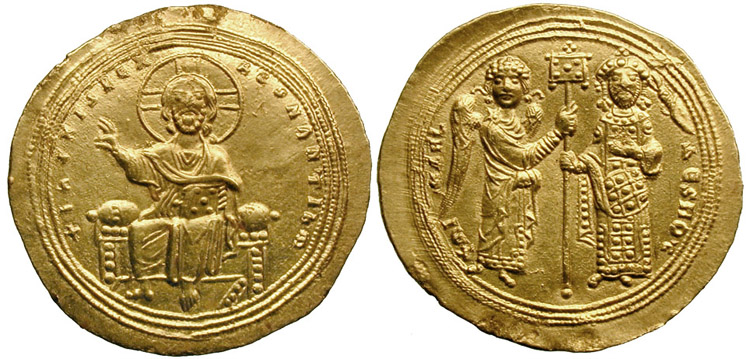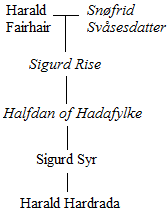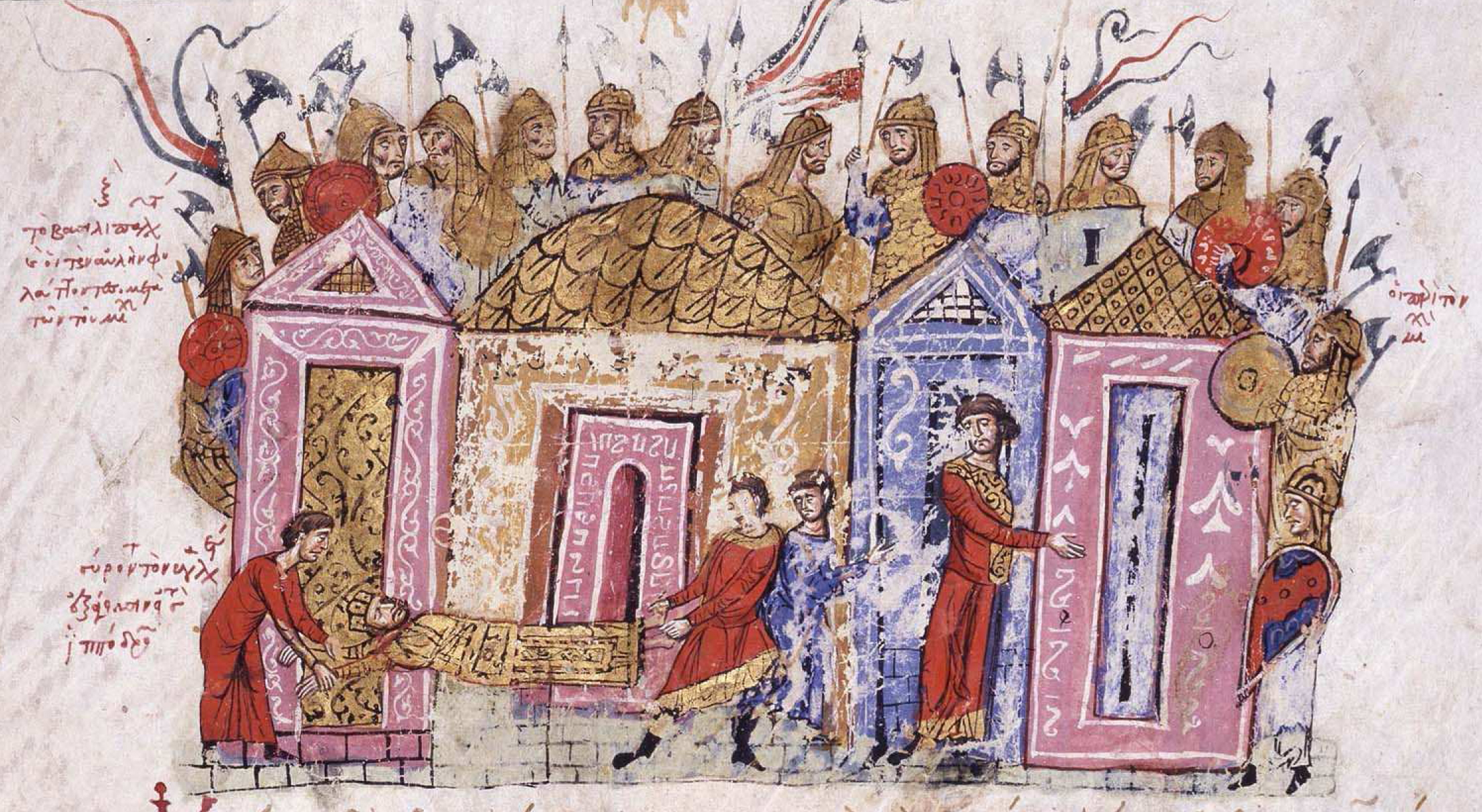|
1041
Year 1041 ( MXLI) was a common year starting on Thursday (link will display the full calendar) of the Julian calendar. Events By place Byzantine Empire * December 10 – Emperor Michael IV (the Paphlagonian) dies after a 6-year reign. His wife, Empress Zoë, elevates (on advice by her lover John the Orphanotrophos) her adoptive son to the throne of the Byzantine Empire, as Michael V Kalaphates. Shortly after, Michael comes into conflict with his uncle John, and banishes him to a monastery. Europe * March 17 – Battle of Olivento: Norman troops and their Lombard allies, led by William I (Iron Arm), are victorious against the Byzantines at the feet of the Monte Vulture, near the River Olivento in Apulia. * May 4 – Battle of Montemaggiore: Lombard-Norman rebel forces, led by William I, are again victorious, and defeat a Byzantine army (18,000 men) on a hill named Montemaggiore, near the River Ofanto. * September 3 – Battle of Montepeloso: Lo ... [...More Info...] [...Related Items...] OR: [Wikipedia] [Google] [Baidu] |
Michael IV The Paphlagonian
Michael IV the Paphlagonian ( el, , ''Mikhaēl ho Paphlagōn''; c. 1010 – 10 December 1041) was Byzantine Emperor from 11 April 1034 to his death on 10 December 1041. The son of a peasant, Michael worked as a money changer until he was found a job at court by his brother John the Orphanotrophos. He caught the eye of the empress Zoë Porphyrogenita and they began a tempestuous and flagrant affair. It is believed that they conspired to murder her husband, Emperor Romanos III Argyros, who died in 1034. Michael and Zoë were married the same day and Michael was crowned emperor the day after. Michael, handsome and energetic, had poor health and entrusted most of the business of government to his brother. He distrusted Zoë and went to lengths to ensure that he did not suffer the same fate as his predecessor. The fortunes of the Empire under Michael's reign were mixed. His most triumphant moment came in 1041 when he led the imperial army against Bulgarian rebels. He returned fro ... [...More Info...] [...Related Items...] OR: [Wikipedia] [Google] [Baidu] |
Battle Of Montemaggiore
The Battle of Montemaggiore (or Monte Maggiore) was fought on 4 May 1041, on the river Ofanto near Cannae in Byzantine Italy, between Lombard-Norman rebel forces and the Byzantine Empire. The Norman William Iron Arm led the offence, which was part of a greater revolt, against Michael Dokeianos, the Byzantine Catepan of Italy. Suffering heavy losses in the battle, the Byzantines were eventually defeated, and the remaining forces retreated to Bari. Dokeianos was replaced and transferred to Sicily as a result of the battle. The victory provided the Normans with increasing amounts of resources, as well as a renewed surge of knights joining the rebellion. Background The battle was fought on 4 May 1041, less than two months after the Battle of Olivento,. the first battle of a renewed revolt of Lombard-Norman forces against the Byzantine Empire. instigated by Arduin the Lombard. The battle at Olivento was the first battle between Normans and Byzantines since the Battle of Cannae in ... [...More Info...] [...Related Items...] OR: [Wikipedia] [Google] [Baidu] |
Michael V Kalaphates
Michael V Kalaphates ( grc-gre, Μιχαήλ Καλαφάτης) was Byzantine emperor for four months in 1041–1042. He was the nephew and successor of Michael IV and the adoptive son of Michael IV's wife Empress Zoe. He was popularly called "the Caulker" (''Kalaphates'') in accordance with his father's original occupation. Family Michael V was the son of a couple named Stephen and Maria. His birth date is not known, but is sometimes given as 1015, probably because he was considered "young" in 1035. Michael's mother was a sister of the Byzantine emperor Michael IV and Stephen had been a caulker before becoming an admiral under Michael IV and then botching an expedition to Sicily. Although the emperor preferred another of his nephews, the future Michael V was advanced as heir to the throne by his other uncle John the Orphanotrophos and the Empress Zoe. In 1035, Michael IV granted him the title of ''kaisar'' (caesar), and, together with Zoe, adopted his nephew as a son. M ... [...More Info...] [...Related Items...] OR: [Wikipedia] [Google] [Baidu] |
Battle Of Olivento
The Battle of Olivento was fought on 17 March 1041 between the Byzantine Empire and the Normans of southern Italy and their Lombard allies near the Olivento river, between the actual Basilicata and Apulia, southern Italy. History The battle had its origin in the decision of Arduin the Lombard, a Greek-speaking Lombard who had fought for the Byzantines, to change sides and form a coalition with the Normans Rainulf Drengot and the Hauteville brothers (William Iron Arm, Drogo, Humphrey), and the Lombards Atenulf of Benevento and Argyrus of Bari. Once having defeated the imperial armies, they would take for themselves the conquered lands. The Byzantine catepan of Italy, Michael Dokeianos, moved from Bari with the few troops he could muster, including some Varangians, troops from the Opsikion '' tagma'' and several Thracesians. He was able to defeat the first rebel troops he met, and he pursued them at Ascoli Satriano. Here he was met by an army of 300 Norman Knights and 600 ... [...More Info...] [...Related Items...] OR: [Wikipedia] [Google] [Baidu] |
Exaugustus Boioannes
Exaugustus Boiοannes ( it, Exaugusto Bugiano), son of the famous Basil Boioannes, was also a catepan of Italy, from 1041 to 1042.He was released in February 1042 from captivity, at which time he was replaced by Synodianos. He replaced Michael Dokeianos after the latter's disgrace in defeat at Montemaggiore on May 4. Boioannes did not have the levies and reinforcements that Doukeianos had had at his command. He arrived only with a Varangian contingent. Boioannes decided on trying to isolate the Lombard rebels in Melfi by camping near Montepeloso. According to William of Apulia, prior to battle Exaugustus made a speech to the troops as follows: The Normans, however, sortied from Melfi and camped on the Monte Siricolo, near Montepeloso. They captured a convoy of livestock meant for the Greek camp and forced a battle, in which Boioannes was defeated and captured (September 3, 1041). The Normans, as mere mercenaries, turned the captive catepan over to the Lombard leader Atenulf ... [...More Info...] [...Related Items...] OR: [Wikipedia] [Google] [Baidu] |
Battle Of Montepeloso
The Battle of Montepeloso was fought on 3 September 1041 between Lombard-Norman rebel forces and the Byzantine Empire, near Montepeloso in southern Italy. The Byzantines, led by Exaugustus Boioannes, were forced into battle by the rebels, and after a day-long fight the rebels defeated the Byzantine army and captured Boioannes. The decisive rebel victory forced the Byzantines to retreat to the coastal cities, leaving the Normans and Lombards in control of the whole interior of southern Italy. Background The battle of Montepeloso was part of a Lombard-Norman revolt against the Byzantine Empire in southern Italy, with preceding battles at Olivento in March, and at Montemaggiore in May, both rebel victories.. Before the battle, the Normans and Lombards agreed on choosing Atenulf, brother of Pandulf III of Benevento, as their new leader, while the Byzantine Catepan Michael Dokeianos was replaced by Exaugustus Boioannes.. The new overall leader of the revolt, Atenulf, was part of th ... [...More Info...] [...Related Items...] OR: [Wikipedia] [Google] [Baidu] |
Harald Hardrada
Harald Sigurdsson (; – 25 September 1066), also known as Harald III of Norway and given the epithet ''Hardrada'' (; modern no, Hardråde, roughly translated as "stern counsel" or "hard ruler") in the sagas, was King of Norway from 1046 to 1066. Additionally, he unsuccessfully claimed both the Danish throne until 1064 and the English throne in 1066. Before becoming king, Harald had spent around fifteen years in exile as a mercenary and military commander in Kievan Rus' and as a chief of the Varangian Guard in the Byzantine Empire. When he was fifteen years old, in 1030, Harald fought in the Battle of Stiklestad together with his half-brother Olaf Haraldsson (later Saint Olaf). Olaf sought to reclaim the Norwegian throne, which he had lost to the Danish king Cnut the Great two years prior. In the battle, Olaf and Harald were defeated by forces loyal to Cnut, and Harald was forced into exile to Kievan Rus' (the sagas' ). He thereafter spent some time in the army of Grand Pri ... [...More Info...] [...Related Items...] OR: [Wikipedia] [Google] [Baidu] |
Zoë Porphyrogenita
Zoë Porphyrogenita ( grc-x-medieval, Ζωή Πορφυρογέννητη "life"; 978 – 1050) was a member of the Macedonian dynasty who breifly reigned as Byzantine Empress in 1042, alongside her sister Theodora. Before that she was enthroned as empress consort to a series of co-rulers, two of whom were married to her. Zoë was born when her father Constantine was nominal co-emperor to his brother, Basil II. After a marriage to Holy Roman Emperor Otto III in 996 failed to materialise, Zoë spent subsequent years in the imperial palace. Basil died in 1025 when Zoë was 47, and her father acceeded the Byzantine throne as Constantine VIII. As he had no sons, Constantine hoped to continue the dynasty by marrying off one of his daughters. Zoë, aged 50, was married to Romanos Argyros. They took the throne the next day on her father's death. The marriage of Zoë and Romanos III was troubled, and Romanos was found dead in his bath in 1034. His death has been variously attrib ... [...More Info...] [...Related Items...] OR: [Wikipedia] [Google] [Baidu] |
Battle Of Ostrovo
The Battle of Ostrovo occurred in 1041 near Ostrovo, an area close to the lake of the same name in modern Northern Greece. History In 1040 Peter Delyan, an illegitimate relative of Samuel, the Bulgarian Tsar, led an uprising against the Byzantines and was proclaimed Emperor of Bulgaria. He quickly occupied the western Balkan lands from Belgrade to Larissa but in the next year he was betrayed by his cousin Alusian, who blinded him with a knife after he got drunk during a feast. Though blind, Peter Delyan remained in command and met the Byzantines near Ostrovo. The battle itself is unclear but the Bulgarians were defeated mainly with the help of the Varangian Guard, led by Harald Hardrada. Delyan was captured and was sent to Thessaloniki. Alusian, who initially sought to lead the army against the Byzantines, secretly negotiated a deal with Emperor Michael IV at Mosynopolis and was rewarded with a title of ''magistros The ''magister officiorum'' (Latin literally for "Master ... [...More Info...] [...Related Items...] OR: [Wikipedia] [Google] [Baidu] |
Edward The Confessor
Edward the Confessor ; la, Eduardus Confessor , ; ( 1003 – 5 January 1066) was one of the last Anglo-Saxon English kings. Usually considered the last king of the House of Wessex, he ruled from 1042 to 1066. Edward was the son of Æthelred the Unready and Emma of Normandy. He succeeded Cnut the Great's son – and his own half-brother – Harthacnut. He restored the rule of the House of Wessex after the period of Danish rule since Cnut conquered England in 1016. When Edward died in 1066, he was succeeded by his wife's brother Harold Godwinson, who was defeated and killed in the same year by the Normans under William the Conqueror at the Battle of Hastings. Edward's young great-nephew Edgar the Ætheling of the House of Wessex was proclaimed king after the Battle of Hastings in 1066 but was never crowned and was peacefully deposed after about eight weeks. Historians disagree about Edward's fairly long 24-year reign. His nickname reflects the traditional ... [...More Info...] [...Related Items...] OR: [Wikipedia] [Google] [Baidu] |
Varangian Guard
The Varangian Guard ( el, Τάγμα τῶν Βαράγγων, ''Tágma tōn Varángōn'') was an elite unit of the Byzantine Army from the tenth to the fourteenth century who served as personal bodyguards to the Byzantine emperors. The Varangian Guard was known for being primarily composed of recruits from northern Europe, including mainly Norsemen from Scandinavia but also Anglo-Saxons from England. The recruitment of distant foreigners from outside Byzantium to serve as the emperor's personal guard was pursued as a deliberate policy, as they lacked local political loyalties and could be counted upon to suppress revolts by disloyal Byzantine factions. The Rus' provided the earliest members of the Varangian Guard. They were in Byzantine service from as early as 874. The Guard was first formally constituted under Emperor Basil II in 988, following the Christianization of Kievan Rus' by Vladimir I of Kiev. Vladimir, who had recently usurped power in Kiev with an army of Varan ... [...More Info...] [...Related Items...] OR: [Wikipedia] [Google] [Baidu] |
John The Orphanotrophos
John the ''Orphanotrophos'' ( gr, Ἰωάννης ὁ Ὀρφανοτρόφος), was the chief court eunuch (''parakoimomenos'') during the reign of the Byzantine Emperor Romanos III (r. 1028–1034). John was born in the region of Paphlagonia. His family was Greek and it was said that they had been engaged in some disreputable trade, perhaps money-changing or, according to George Kedrenos, forgery. John was the eldest of five brothers. Two, Constantine and George, were also eunuchs, while the other two, Niketas and Michael, were 'bearded' men; the latter became Michael IV the Paphlagonian after John introduced him to the reigning empress Zoë. According to Michael Psellos, the two became lovers and could have hatched a plot to assassinate Zoë's husband, then reigning. Romanos was presumably killed in his bath on 11 April 1034. Certain contemporary sources implicate John in this assassination. Background John first comes to historical attention as '' protonotarios'' and t ... [...More Info...] [...Related Items...] OR: [Wikipedia] [Google] [Baidu] |


.jpg)




